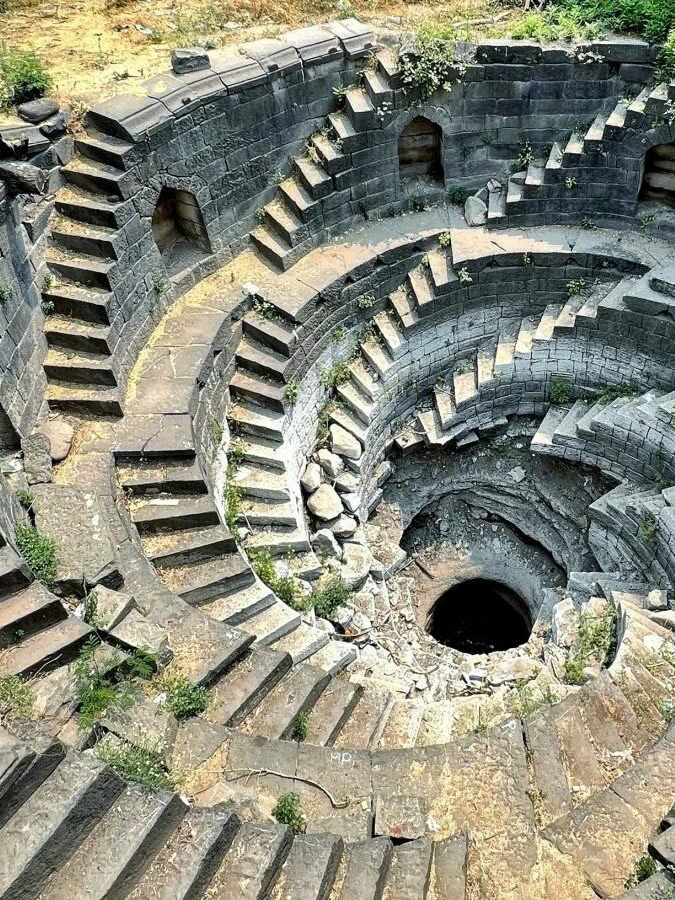The heart of Maharashtra’s Parbhani District, nestled within the serene boundaries of Selu Taluka, cradles an extraordinary relic of ancient Indian ingenuity—the Helical Stepwell of Walur. Estimated to be between 1,000 and 1,500 years old, this magnificent creation transcends its primary function as a water reservoir. It is a dazzling example of architectural innovation and artistic excellence, capturing the brilliance of ancient engineering and cultural expression.
The uniqueness of the Helical Stepwell lies in its breathtaking spiral design, which seamlessly blends functionality with aesthetic appeal. Unlike conventional stepwells, which often feature linear or symmetrical staircases, the Walur stepwell invites visitors on a mesmerizing journey through its helical structure. Descending into its depths feels like stepping back in time, with every turn and twist of its eight interconnected staircases revealing a deeper layer of history. This structural design not only facilitated practical water access but also elevated the stepwell into a masterpiece of design ingenuity. Each staircase interlocks with the others, creating a stunning visual effect while ensuring that people could easily reach the water, regardless of the seasonal fluctuations in the water level.

Beyond its architectural brilliance, the Walur stepwell holds profound cultural and spiritual significance. Carved into the structure are eight Devakoshta niches, which once likely housed detailed sculptures or carvings that reflected the spiritual ethos of the era. These niches served as sanctified spaces, embodying the deep connection between functionality and spirituality. In ancient India, water was not merely a resource but a sacred element, essential for life and revered in rituals. The presence of these niches suggests that the stepwell was more than a utilitarian structure; it was a spiritual haven where people could gather for rituals, community bonding, and moments of introspection. This harmonious union of practicality and spirituality underscores the remarkable depth of thought that went into its creation.
The geographical location of Walur in a region often plagued by water scarcity highlights the critical role this stepwell played in sustaining the local community. During periods of severe drought, the stepwell’s thoughtful design ensured that water remained accessible. Its depth and helical structure allowed for a gradual descent, making it possible to reach the water even when levels were at their lowest. More than a reservoir, the stepwell became a vital hub of daily life. It was here that people met, exchanged stories, and strengthened their social bonds. The Helical Stepwell of Walur was not merely a source of water; it was the heart of the community—a lifeline that supported both the physical and social well-being of its people.
While the grandeur of this ancient marvel is undeniable, its story does not end with its construction. Over centuries, neglect and natural wear threatened to erase this treasure from history. However, the dedication of local villagers has ushered in a new chapter for the Walur stepwell. In recent years, restoration efforts led by these passionate individuals have cleared debris and revealed the stepwell’s original splendor. Their work stands as a testament to the enduring pride and respect for India’s architectural heritage. By restoring this stepwell, they have not only preserved a vital piece of history but have also created an opportunity for future generations to learn from and appreciate the ingenuity of their ancestors.
Today, the Helical Stepwell of Walur proudly joins the ranks of India’s most iconic architectural sites, such as Rani-ki-Vav in Gujarat and Agrasen Ki Baoli in Delhi. Despite its historical significance, this stepwell remains relatively lesser-known, waiting to be discovered by curious travelers and history enthusiasts. Its unique design and cultural value make it a hidden gem that deserves to be celebrated on both national and global stages. For those who seek to understand the depth of India’s ancient ingenuity, the Walur stepwell offers an unparalleled glimpse into the past.
The beauty of the Helical Stepwell of Walur lies not only in its physical structure but also in the stories it tells. It stands as a living testimony to the resilience, creativity, and community spirit of the people who built it. At its core, the stepwell is a celebration of human innovation—a reminder that our ancestors were not merely focused on survival but were also visionaries capable of transforming basic necessities into breathtaking works of art. The intricate design of the stepwell reflects a deep understanding of engineering principles, while its artistic elements showcase an appreciation for beauty and spirituality.
The Helical Stepwell of Walur also challenges modern perceptions of ancient societies. Too often, ancient civilizations are seen as primitive or simplistic, yet structures like this stepwell reveal a sophistication that rivals, and sometimes surpasses, modern engineering and design. The stepwell demonstrates how necessity can inspire unparalleled creativity. Faced with the challenge of water scarcity, the people of Walur not only solved a practical problem but did so in a way that celebrated life, culture, and artistry.
Visiting the stepwell today is a journey through time—a chance to witness the genius of ancient minds and to reflect on the enduring legacy of their efforts. It is a poignant reminder of the importance of preserving such heritage sites, as they hold invaluable lessons for future generations. The Helical Stepwell of Walur is not just a relic of the past but a source of inspiration for the present and future. Its story encourages us to think beyond the ordinary, to merge functionality with creativity, and to honor the interconnectedness of community, culture, and environment.
In conclusion, the Helical Stepwell of Walur is much more than a water reservoir; it is a narrative etched in stone, celebrating human ingenuity, cultural richness, and spiritual depth. Its helical design, cultural significance, and enduring legacy make it a symbol of the extraordinary achievements of ancient Indian society. As we uncover and restore such treasures, we not only pay homage to the past but also enrich our understanding of humanity’s boundless potential for innovation and artistry. The Walur stepwell stands as a timeless beacon, reminding us of the beauty and resilience that define the human spirit.





